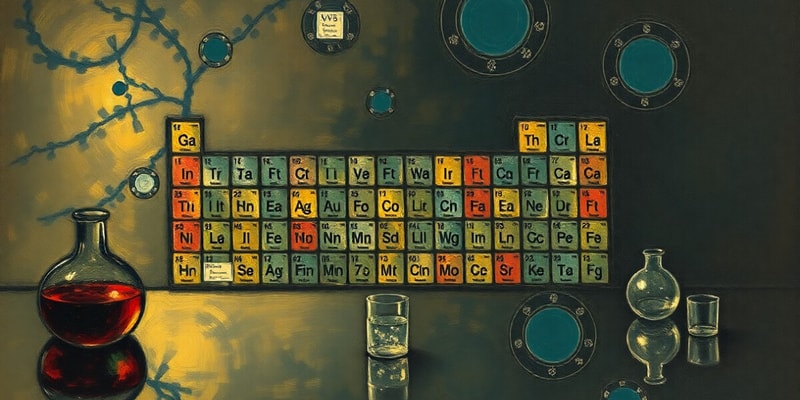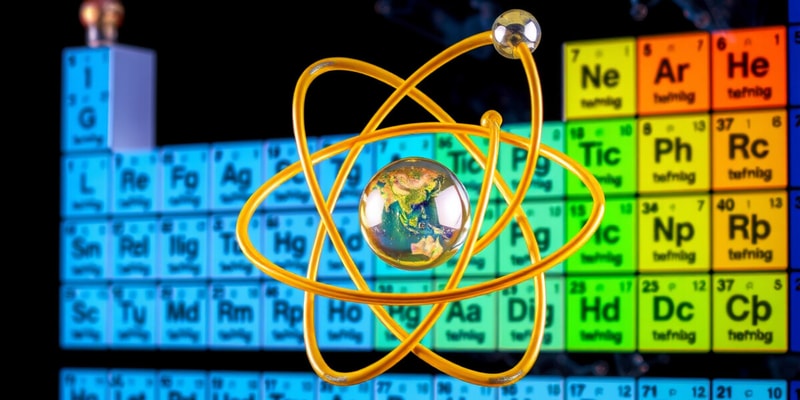Podcast
Questions and Answers
What are elements in chemistry?
What are elements in chemistry?
What does the atomic number of an element represent?
What does the atomic number of an element represent?
Which type of chemical bond is formed when two atoms share electrons?
Which type of chemical bond is formed when two atoms share electrons?
What are reactants in a chemical reaction?
What are reactants in a chemical reaction?
Signup and view all the answers
What term describes the number of particles in a mole?
What term describes the number of particles in a mole?
Signup and view all the answers
Which of the following describes bases?
Which of the following describes bases?
Signup and view all the answers
What happens during an endothermic reaction?
What happens during an endothermic reaction?
Signup and view all the answers
What is the pH scale used to measure?
What is the pH scale used to measure?
Signup and view all the answers
Study Notes
Basic Concepts of Chemistry
- Matter: Anything that has mass and occupies space.
- Elements: Pure substances that cannot be broken down (e.g., Hydrogen, Oxygen).
- Compounds: Substances formed from two or more elements chemically combined (e.g., Water - H₂O).
Atomic Structure
-
Atoms: Basic unit of matter; consist of protons, neutrons, and electrons.
- Protons: Positively charged, located in the nucleus.
- Neutrons: Neutral, located in the nucleus.
- Electrons: Negatively charged, orbit the nucleus in electron shells.
- Atomic Number: Number of protons in an atom; defines the element.
- Mass Number: Total number of protons and neutrons in an atom's nucleus.
The Periodic Table
- Groups (Columns): Elements with similar chemical properties; denoted by numbers (1-18).
- Periods (Rows): Represents energy levels of electrons.
- Metals, Nonmetals, and Metalloids: Classification based on properties.
Chemical Bonds
- Ionic Bonds: Formed when electrons are transferred from one atom to another (e.g., NaCl).
- Covalent Bonds: Formed when two atoms share electrons (e.g., H₂O).
- Metallic Bonds: Found in metals, where electrons are shared over many nuclei.
Chemical Reactions
- Reactants: Substances present before a reaction.
- Products: Substances formed after a reaction.
-
Types of Reactions:
- Synthesis: Combining elements to form a compound.
- Decomposition: Breaking down a compound into simpler substances.
- Single Replacement: One element replaces another in a compound.
- Double Replacement: Exchange of ions between two compounds.
- Combustion: Reaction with oxygen producing energy.
Stoichiometry
- Mole Concept: A mole is 6.022 x 10²³ particles; used for counting atoms/molecules.
- Balanced Equations: Must have the same number of atoms of each element on both sides.
Acids and Bases
- Acids: Substances that donate protons (H⁺) in solution (e.g., HCl).
- Bases: Substances that accept protons or donate hydroxide ions (OH⁻) (e.g., NaOH).
- pH Scale: Measures acidity/basicity; ranges from 0 (acidic) to 14 (basic), with 7 as neutral.
Thermochemistry
- Endothermic Reactions: Absorb heat energy (surroundings become cooler).
- Exothermic Reactions: Release heat energy (surroundings become warmer).
- Enthalpy (ΔH): Total heat content of a system, which changes during a reaction.
Organic Chemistry
- Hydrocarbons: Compounds consisting solely of hydrogen and carbon (e.g., methane - CH₄).
- Functional Groups: Specific groups of atoms within molecules that are responsible for characteristic reactions (e.g., -OH in alcohols).
Biochemistry
- Macromolecules: Large complex molecules essential for life (e.g., proteins, carbohydrates, lipids, nucleic acids).
- Enzymes: Biological catalysts that speed up reactions without being consumed.
Laboratory Safety
- Always wear protective gear (gloves, goggles).
- Know the location of safety equipment (eyewash, fire extinguisher).
- Follow proper disposal procedures for chemicals.
Matter and Its Components
- Matter is anything that occupies space and has mass.
- Elements are pure substances that cannot be broken down into simpler substances. Some well-known examples include hydrogen (H), oxygen (O), nitrogen (N), and carbon (C).
- Compounds are formed when two or more elements combine chemically in a fixed ratio. For example, water (H₂O) is a compound formed by the chemical combination of hydrogen and oxygen.
Atomic Structure
- The atom is the fundamental building block of matter, consisting of three subatomic particles: protons, neutrons, and electrons.
- Protons are positively charged particles located in the atom's nucleus.
- Neutrons have no charge (neutral) and are also located in the nucleus.
- Electrons are negatively charged particles that orbit the nucleus in specific energy levels called electron shells.
- The atomic number of an element is the number of protons in its nucleus. This number defines the element and its place on the periodic table.
- The mass number represents the total number of protons and neutrons in the atom's nucleus.
The Periodic Table: Organizing the Elements
- The periodic table is a systematic arrangement of elements based on their atomic numbers and chemical properties.
- Groups (columns) in the periodic table represent elements with similar chemical properties. They are numbered from 1 to 18.
- Periods (rows) represent the energy levels of electrons in an atom.
- Elements are classified as metals, nonmetals, and metalloids based on their physical and chemical properties.
Chemical Bonds: Holding Atoms Together
- Chemical bonds are forces that hold atoms together in molecules and compounds.
- Ionic bonds form when electrons are transferred from one atom to another, resulting in the formation of ions (charged atoms). For instance, sodium chloride (NaCl) forms through an ionic bond.
- Covalent bonds occur when two atoms share electrons. An example is the water molecule (H₂O), where hydrogen and oxygen share electrons to form a stable molecule.
- Metallic bonds exist in metals, where electrons are delocalized and shared among numerous nuclei.
Understanding Chemical Reactions
- Chemical reactions are processes that involve the rearrangement of atoms and molecules.
- Reactants are the substances that are present before a chemical reaction takes place.
- Products are the substances formed after the reaction is complete.
- There are various types of chemical reactions, including:
- Synthesis: Combining two or more substances to form a new compound.
- Decomposition: Breaking down a compound into simpler substances.
- Single replacement: One element replaces another in a compound.
- Double replacement: Exchange of ions between two compounds.
- Combustion: A rapid reaction with oxygen that produces energy.
Stoichiometry: Quantifying Chemical Reactions
- Stoichiometry deals with the quantitative relationships between reactants and products in chemical reactions.
- The mole concept is a fundamental unit in chemistry, representing 6.022 x 10²³ particles (atoms, molecules, or ions). It provides a way to count atoms and molecules in large quantities.
- Balanced chemical equations are essential for stoichiometric calculations as they ensure that the number of atoms of each element is the same on both sides of the equation.
The Nature of Acids and Bases
- Acids are substances that donate protons (H⁺) when dissolved in water, resulting in a solution with a pH less than 7.
- Bases are substances that accept protons or donate hydroxide ions (OH⁻) in solution, leading to a pH greater than 7.
- The pH scale ranges from 0 to 14, with 7 being neutral. A pH less than 7 indicates an acidic solution, while a pH greater than 7 suggests a basic solution.
Thermochemistry: Heat Changes in Reactions
- Thermochemistry studies the heat changes that occur during chemical reactions.
- Endothermic reactions absorb heat energy from the surroundings, causing the temperature of the surroundings to decrease.
- Exothermic reactions release heat energy to the surroundings, increasing the temperature of the surroundings.
- Enthalpy (ΔH) represents the total heat content of a system, and its change (ΔH) indicates the amount of heat absorbed or released during a reaction.
Organic Chemistry: The Chemistry of Life
- Organic chemistry is devoted to the study of carbon-containing compounds.
- Hydrocarbons are organic molecules composed solely of hydrogen and carbon. Methane (CH₄) is a simple example.
- Functional groups are specific groups of atoms within molecules that are responsible for characteristic reactions. For example, the -OH group (hydroxyl group) is present in alcohols.
Biochemistry: Chemistry of Living Systems
- Biochemistry is the study of chemical processes within living organisms.
- Macromolecules are large, complex molecules essential for life. Examples include proteins, carbohydrates, lipids (fats), and nucleic acids (DNA and RNA).
- Enzymes are biological catalysts that speed up chemical reactions without being consumed in the process.
Laboratory Safety: A Priority
- Laboratory safety is crucial to prevent accidents and injuries.
- Always wear protective gear such as gloves, goggles, and lab coats.
- Familiarize yourself with the location of safety equipment like eyewash stations, fire extinguishers, and emergency exits.
- Follow proper disposal procedures for chemicals to minimize environmental harm.
Studying That Suits You
Use AI to generate personalized quizzes and flashcards to suit your learning preferences.
Description
Explore the fundamental concepts of chemistry, including matter, atomic structure, the periodic table, and chemical bonds. This quiz covers the essential definitions and classifications that form the basis of chemistry. Test your understanding of elements, compounds, and the structure of atoms.




